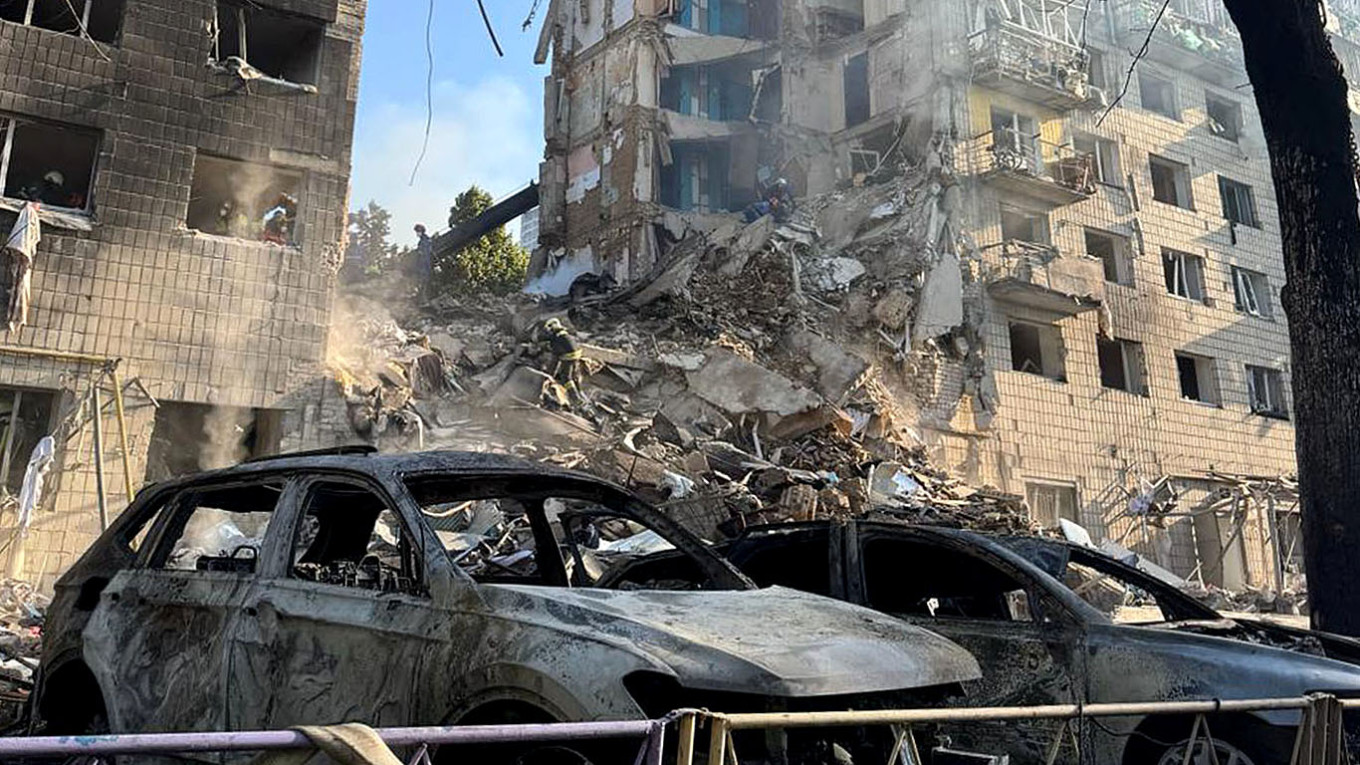KYIV, Ukraine — Officials reported that at least 15 individuals lost their lives and nearly 100 were injured overnight as Russia executed one of its most significant assaults on the Ukrainian capital in recent months.
In the early hours of Tuesday morning, Russia launched a coordinated attack, utilizing drones, ballistic missiles, and cruise missiles.
By the conclusion of the 10-hour air raid alert around 6:00 a.m., the city was enveloped in a thick haze of smoke.
A nine-story residential building in the Solomyanskyi district of Kyiv suffered multiple strikes from Shahed drones and a ballistic missile, resulting in a complete collapse of one section of the structure.
“Initially, three drones were spotted, prompting us to head to the shelter,” recounted Svitlana, a 55-year-old grandmother who has resided in the building since she was 12. “The Russians deploy drones first, wait for the State Emergency Service to respond, and then follow up with missile strikes to maximize casualties.”
Alongside her neighbors, Svitlana collected shards of glass and assessed the damage to their homes.
Eager to communicate with foreign reporters, Svitlana called her granddaughter, who could express their experience in English.
“This is nonsense,” declared 15-year-old Liza regarding the attack. “We took shelter, there were numerous explosions. I’m in shock — it’s a lot to handle.”
According to Timur Tkachenko, head of the military administration in the Ukrainian capital, Russia targeted Kyiv with 175 drones, over 14 cruise missiles, and at least two ballistic missiles.
Amid the wreckage, locals, visibly fatigued, gazed at the devastation of their neighborhood, sobbing and holding on to one another for comfort.
“This was my parents’ apartment, and now it’s mine. I’ve lived here my entire life. However, today three Shahed drones struck our street, and then a missile destroyed our home,” lamented one neighbor to The Moscow Times, choosing to remain unnamed.
A man, clearly traumatized and covered in blood, sat against a fence facing the ruined structure, staring blankly. Speaking in Russian, he shared that his “father is in the village, and my mother has been taken to intensive care. Things do not look good.”
Emergency personnel from Ukraine’s State Emergency Service arrived shortly after the attack, searching through the debris for possible survivors and securing the area.
While addressing reporters, Kyiv Mayor Vitali Klitschko stated, “With each passing minute, the number of injured and deceased is rising; we cannot accurately determine the total casualties.”
The aftermath of the assault has been reported at 12 distinct sites across the Solomianskyi, Sviatoshynskyi, Darnytskyi, Dniprovskyi, Podilskyi, and Obolonskyi districts of Kyiv.
Klitschko shared a video on his Telegram channel purportedly showing evidence of Russia’s use of cluster munitions “to inflict maximum casualties. There is simply no other way to describe it.”
Later on Tuesday, Russia’s Defense Ministry asserted it had conducted “high-precision strikes” on military locations in both Kyiv and Zaporizhzhia regions. “The objectives of the strikes have been accomplished, with all targeted sites hit,” the statement claimed.
In recent months, Russia has intensified the frequency and severity of its attacks on the capital and other Ukrainian cities amidst U.S. efforts to facilitate a peace agreement with Russia while decreasing military support for Ukraine.
Moscow has also stepped up its offensive actions along the extensive 1,000-kilometer front to pressure Ukraine into submission to its maximalist demands.
The attack on Tuesday coincided with the G7 summit taking place in Canada, where Ukrainian President Volodymyr Zelensky was anticipated to urge the U.S. for enhanced sanctions against Russia and increased assistance for Ukraine.
However, President Donald Trump departed the summit early to return to Washington due to the escalating air conflict between Israel and Iran, dampening Ukrainian expectations for attention from U.S. leadership.
At 7:59 a.m. Kyiv time, air raid sirens blared once more as another Russian ballistic missile was detected heading towards the city, causing widespread panic among residents.
In anticipation of a “double tap” strike — a strategy involving an initial missile followed by a subsequent attack targeting rescuers and survivors — bystanders, emergency responders, and residents still recovering from the initial assault scrambled for safety. Streets that had just begun to fill with aid workers and journalists cleared almost instantly as Kyiv braced for another strike.
However, this time, the missiles did not reach their intended target.

